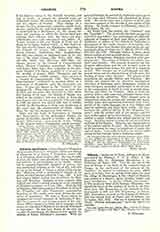

Sidonius APOLLINARIS SIDONIUS), Christian author and Bishop of Clermont, b. at Lyons, November 5, about 430; d. at Clermont, about August, 480. He was of noble descent, his father and grandfather being Christians and prefects of the pretorium of the Gauls. About 452 he married Papianilla, daughter of Avitus, who was proclaimed emperor at the end of 455, and who set up in the Forum of Traj an a statue of his son-in-law. Sidonius wrote a panegyric in honor of his father, who had become consul on January 1, 456. A year had elapsed before Avitus was overthrown by Ricimer and Majorian. Sidonius at first resisted, then yielded and wrote a second panegyric on the occasion of Majorian’s journey to Lyons (458). After the fall of Majorian, Sidonius supported Theodoric II, King of the Visigoths, and after Theodoric’s assassination hoped to see the empire arise anew during the consulate of Anthemius. He went to Rome, where he eulogized the second consulate of Anthemius (January 1, 468) in a panegyric, and became prefect of the city. About 470 he returned to Gaul, where contrary to his wishes he was elected Bishop of the Arveni (Clermont in Auvergne). He had been chosen as the only one capable of maintaining the Roman power against the attacks of Euric, Theodoric’s successor. With the general Ecdicius, he resisted the barbarian army up to to the time when Clermont fell, abandoned by Rome (474). He was for some time a prisoner of Euric, and was later exposed to the attacks of two priests of his diocese. He finally returned to Clermont, where he died (Epist., IX, xii).
His works form two groups, the “Carmina” and the “Epistulae”. The poems are the three panegyrics with their appendixes; two epithalamia; an acknowledgment to Faustus of Reji (now Riez), a eulogy of Narbonne, or rather, of two citizens of Narbonne; a description of the castle (burgas) of Leontius, etc. The letters have been divided into nine books, the approximate dates of which are: I, 469; II, 472; V-VII, 474-475; IX, 479. Although written in prose, these letters contain several metrical pieces. After his conversion to Christianity, Sidonius ceased to write profane poetry. The poems of Sidonius are written in a fairly pure latinity. The prosody is correct, but the frequent alliterations and the use of short verses in lengthy compositions betray the poet of a decadent period. The excessive use of mythological and allegorical terms and the elaboration of details make the reading of these works tiresome. The sources of his inspiration are usually Statius and Claudian. His defects are atoned for by powerful descriptions (sketches of barbarian races, landscapes, details of court intrigues) noticeable particularly in his letters, in the composition of which he took as models Symmachus and Pliny the Younger. Most of them are genuine letters, only somewhat retouched before their insertion in the collection. They abound more in mannerisms than the poems and contain also many archaic words and expressions borrowed from every period of the Latin language; he is very diffuse and runs to antithesis and plays upon words. He foreshadows the artificial diction of the “Hisperica Tamina”, only the artistic skill of the painter and the story-teller makes up for these defects. These letters exhibit a highly colored and unique picture of the times. Sidonius wished to unite the service of Christ and that of the Empire. He is the last representative of the ancient culture in Gaul. By his works as well as by his career, he strove to perpetuate it under the aegis of Rome; eventually he had to be content with saving its last vestiges under a barbarian prince.
PAUL LEJAY

